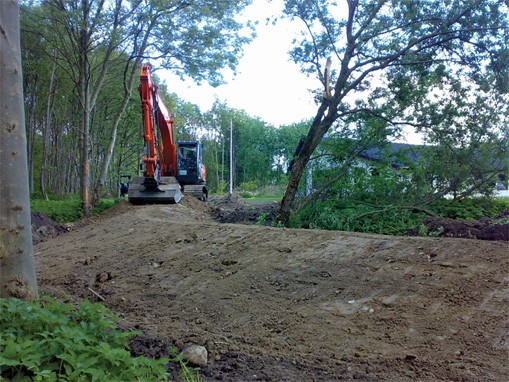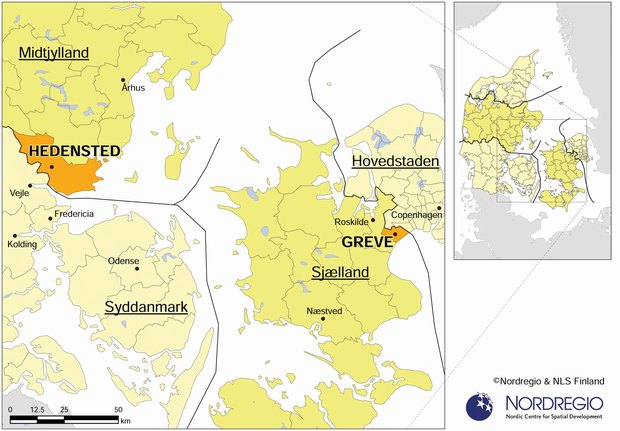
Example of adaption measures in Greve. A new barrier is being buil to prevent future flooding. Photo: Greve municipality.
The national adaption strategy, released in March 2008, concludes that Denmark will experience more extreme weather conditions with overall higher temp- eratures and also more rain in addition to a future rise in sea levels. Little is however said about the concrete work needed to adapt to climate change. Instead the idea is that the national strategy should function as a tool to help coordinate ad hoc measures for both the public and private actors. The municipalities are thus left with sole responsibility for the carrying out of adaptation work.
The recent Danish municipal reform process saw the total number of municipalities reduced from 275 to 98. In addition the new municipalities received increased responsibilities in terms of safeguarding against climate change. The municipalities do not however feel they can adequately cope with the new situation, insisting that they need further support form the national level. Two municipalities reflective of this situation were studied in the context of the Municipal Responses to Climate Change Emergencies project, namely, Greve and Hedensted.
Greve www.greve.dk
Inhabitants: 47773 Area: 60.2 km2
One Danish municipality that has been forced to instigate large scale adaptation measures is Greve. Located on the coast in the southern part of the greater Copenhagen area and situated in lowland terrain, Greve can be said to be one of the most flood-prone areas in Denmark.
Given ongoing climate change patterns higher rainfall levels will undoubtedly cause more frequent flooding. The municipal council has therefore decided to upgrade the capacity of the existing drainage and sewage system to be able to carry 30% more water. The planned adaption measures will however be costly and Greve will have to bear significant additional costs in order to adapt to climate change.
Two major flooding events have already occurred this century, in 2002 and 2007. Historically, Greve has been spared such potential disasters in the past but the likelihood of their increased incidence is growing. During the last flooding episode in the summer of 2007 an evacuation was needed in order to protect the inhabitants of the town. The situation put the local rescue services under pressure as flooding temporarily wiped out some of the critical infrastructures while communications and electricity connections were also lost for a time.
In the light of such experiences Greve is now investing significantly in building capacities to cope with future flooding incidences. Adaptation of the city to climate change is undertaken using a so-called 'strategy model' developed by Greve municipality. The model is used to help prioritize those areas of the city to undergo adaptation first.
The strategy model combines a digital terrain model with a hydraulic model. The hydraulic model covers streams and sewer systems. Using various rain scenarios and basic flows in the streams, the model calculates which areas will be flooded first and this is crucial knowledge to have when seeking to put the necessary adaptation measures into place.
Implementation of the model is supported by continuous surveying of the streams and the sewer system to calibrate and validate the model's performance and to raise the alarm in cases where high water levels are found. The vision of Greve is to have a model of the total water system. Greve is therefore developing a model for the groundwater system, which will be combined with the strategy model outlined above.
All of these actions are coordinated with the implementation of the EU flood directive in order to predict future flooding and to mitigate the societal impacts of flooding.
The development of the Greve strategy model is perhaps now the trademark of Greve. The model uses a number of technical tools to provide a better level of knowledge in respect of the local preconditions for flooding which also leads to a better starting point for the implementation of adaptation measures. In this context however it should be stressed that Greve has done this all on its own and has had to bear significant costs (approximately 10.6 million Euro) in respect of the adaptation measures.
Hedensted www.hedensted.dk
Inhabitants: 45561 Area: 546 km2
Adaptation is probably the most significant challenge thrown up by climate change to be dealt with at the municipal level. The fact that municipalities have to work in a more proactive way is proving quite difficult but a few are already taking action regardless of major climate change impacts or major flooding events. One such municipality is that of Hedensted.
Situated on the eastern Jutland coast, Hedensted can be said to be one of the forerunners in Denmark regarding climate change adaptation. This is due to the fact that they regard climate change as an integral part of spatial planning and are aiming at mainstreaming it in future municipal plans from 2009
With only minor flooding along the coast, Hedensted has not yet experienced any significant flooding emergencies. But they have decided to adopt a proactive approach as they have identified that flooding will become a major problem in the future. The reason for Hedensted's adoption of early adaptor or 'pacesetter' status can best be explained by good local knowledge of municipal preconditions, knowledge sharing and a strong municipal consensus culture.
In relation to the successful adoption of the municipal reform process in 2007 the Danish Ministry of Environment, together with one of the largest strategic foundations, Realdania and other stakeholders, began a process called Plan '09. This programme supports the newly formed Danish municipalities in their work on establishing new municipal plans and strategies for their future development. As perhaps the only clear climate change adaptation-related project, Hedensted began a project on mainstreaming climate change adap- tation via their municipal strategies.
As a part of the Plan '09 project, and in order to raise awareness on the local impacts of climate change and the need for adaptation measures, Hedensted has adopted a very straightforward approach. The municipality developed an excursion trip for civil servants and politicians. Each of the participants in the excursion was given a compendium with maps and figures explaining the likely local impacts illustrated during the excursion. Twelve stops were made to present and discuss the specific local preconditions and the future impacts of climate change in each location. The current and potential impacts thus became much more concrete and understandable when displayed in this manner.
In this context the increasing level of municipal responsibility for spatial planning and climate change issues played a significant role here as Hedensted realised that they would not receive much support from the national authorities and that they thus needed to take primary responsibility for them-
selves. Behind this argument lies the conviction that climate change is a process and not a project limited in time and space and furthermore that the effects of climate change are, initially if not primarily, local in occurrence.

By Birgit Paludan, Hydraulic Engineer, Greve municipality - [email protected]
And Per Francke, previous Research Assistant